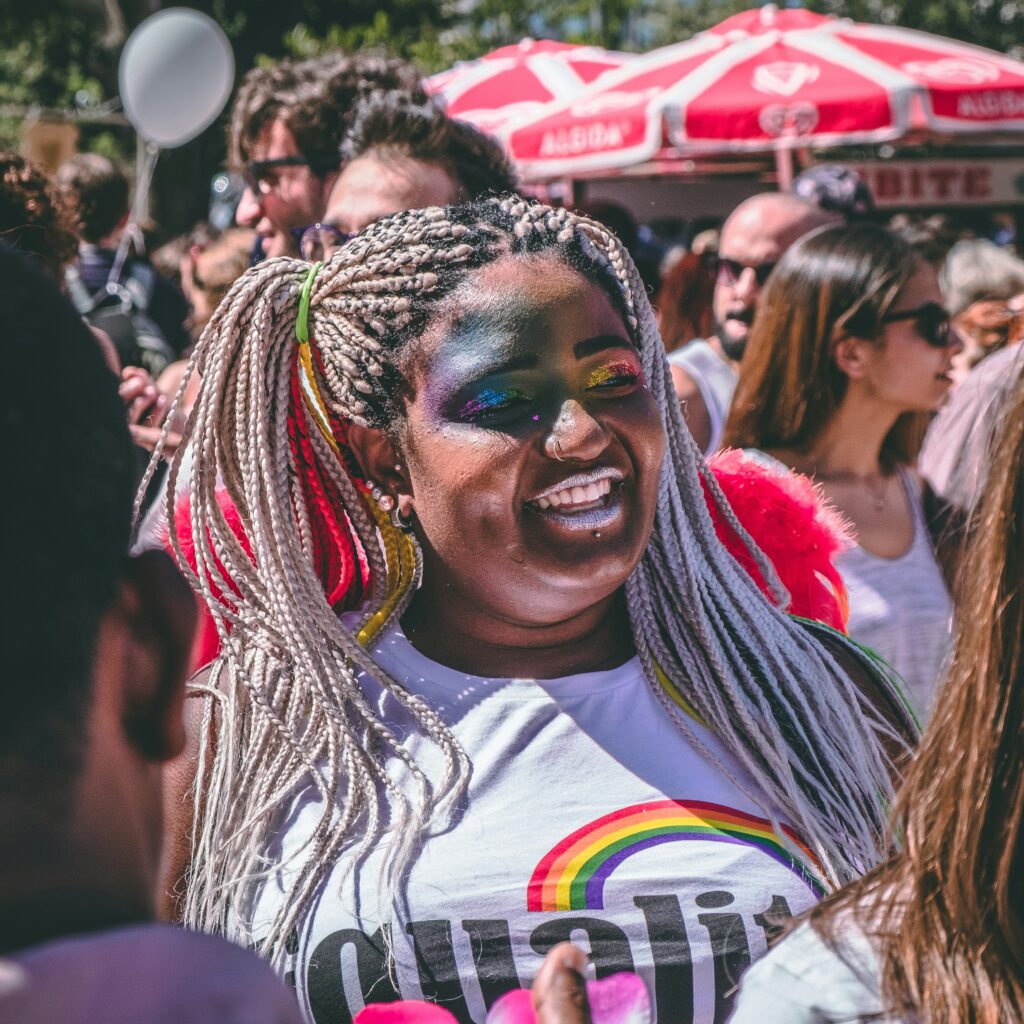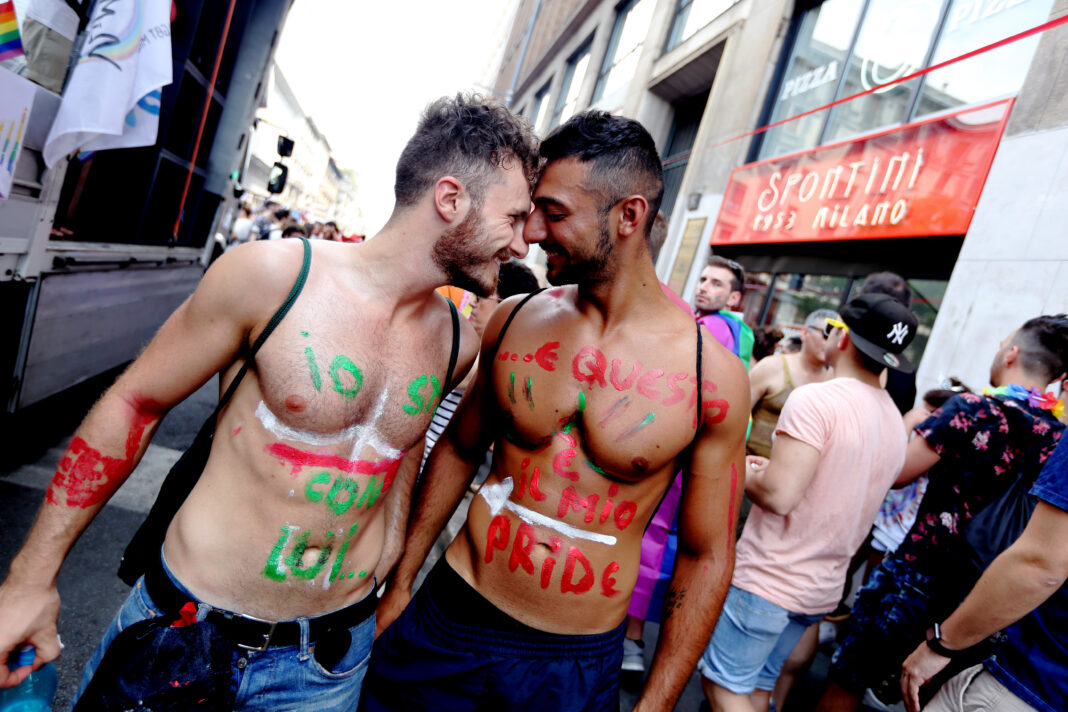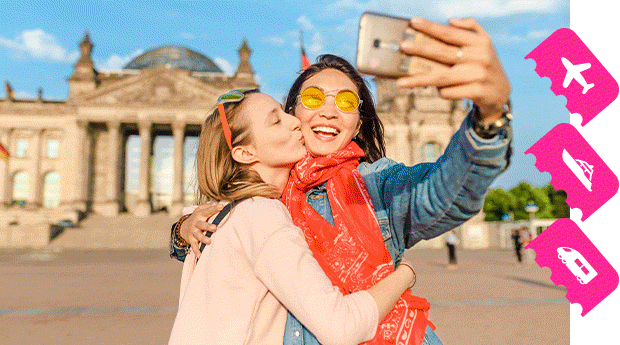After a few moments in Milan, you will feel acutely underdressed. Even if your outfit were rhinestoned from head to toe, it still wouldn’t embody the casual elegance of the Milanese around you. So, just give up and buy a gelato. And get a silk shirt while you’re at it; we could all use an upgrade.

Now, after you’ve accepted the things you cannot change, you can finally enjoy Milan. Yes, the people are all dressed better than you, but that’s the charm of this northern Italian city. Grab a piadina—a classic Italian flatbread snack—and take in the view. Of course, not every meneghino (resident of Milan) will be a style icon, but even the least prosperous meneghinos put their best heel forward. This is one of the fashion capitals of the world, after all. (The next Milan Fashion Week is coming up September 17 to 23.)
After some unforgettable people-watching, you’ll find yourself hungry for a real meal. Luckily, this metro of 1.35 million residents is a great place to be hungry: In addition to piadinas, you’ll find cotoletta (a regional schnitzel), ossobuco (braised veal shank) and world-class risotto. One little-known fact about Italy is that it’s Europe’s top producer of rice.
But there’s much more that foreigners don’t know about Italy and, for the purposes of this insider’s guide, Milan. It’s not just an industrial hub or fashion capital; it’s also a deep well of history and culture. Home to both Leonardo da Vinci’s “The Last Supper” and the splendid Gothic Duomo, Milan contains enough stunning art and architecture to entertain even the most philistine visitors.
It’s also a great place to be queer. One glimpse of the rainbow mural that covers the Porta Venezia metro stop will clue you in. The rainbow window decals that peek out from the storefronts of Via Lecco, Milan’s main LGBTQ+ district, confirm it. Of course, this puts Milan at odds with the rest of Italy, which lags behind other Western European countries in terms of queer rights. Thanks to influence from the pesky Catholic Church and more recently the country’s far-right prime minister Georgia Meloni, Italy doesn’t recognize same-gender marriage or adoption rights; however, it does endorse same-sex civil unions, and the majority of Italy’s populace quietly believe society should accept homosexuality.
Milan may be the most queer-friendly city in Italy. It can be hard to tell sometimes—as one meneghino tells us, gays and Italians are visually interchangeable—but Milan is teeming with same-sex couples. Via Lecco and the Rainbow District, which supports the LGBTQ+ character of the neighbourhood of Porta Venezia, are busy places, and the Rainbow District organization regularly collaborates with Milanese institutions. You might credit this phenomenon to the city’s centuries-long artistic tradition that begins with the pre-Roman Gauls and culminates in Milan’s modern-day fashion weeks. When tush comes to shlong, any city that housed Leonardo Da Vinci is at least a little queer.
Speaking of the “almost certainly gay” artist, his famous The Last Supper may as well be your entry point to the city’s captivating history. Once you view the painting in its home at the convent of Santa Maria delle Grazie (Piazza di Santa Maria delle Grazie, Milan) and breathe the same air as the master, you’ll be hooked on Milan’s cultural and historical offerings. You’ll soon seek out the sixth-century B.C. ruins of Mediolanum, the stately Roman Colonne di San Lorenzo and the medieval splendour of Sforzesco Castle. With the right guide, you’ll learn how Sforza helped transform Milan from a Dark Ages industrial hub into a silk-laden Renaissance tour de force and future fashion fairyland. You may even spot the infamous Il Dito (P.za degli Affari, Milan), or the “middle finger statue,” which silently flicks off either Italy’s fascist history or narcissistic finance bros, depending on whom you ask. As you might gather, Italians are not openly proud of the country’s flirtation with fascism in the 20th century, and fascist salutes are now mostly illegal.
That’s not to say that Milan resembles anything like its former Roman, medieval or even Renaissance self. For instance, the ancient Roman ruins of Colonne di San Lorenzo are now flanked by urban-core boutiques, graffiti-shrouded storefronts, punk pop-ups and handsome young drug dealers with whom you shouldn’t make eye contact. Meanwhile, Brera, the city’s former Bohemian neighbourhood, is now crawling with wealthy Maltese owners dressed in the finest fabrics, no doubt spun by the local silkworms that devour Milan’s famous mulberries.
Continuing beyond the sinuous paths and back-alley boutiques of Brera, you’ll find engrossing contemporary art centres like the Fondazione Prada (L.go Isarco 2, Milan) and Museo delle Culture (Via Tortona 56, Milan), in Porta Romana and Navigli, respectively. The former neighbourhood makes for an enchanting daytime stroll, whereas the latter, with its glittering stretch of canal-front restaurants and bars, provides a perfect dinner setting. Top it all off with a night spent roaming the bars of Via Lecco and you’ll feel like a meneghino in no time. Well, minus the chic outfit.
Here is the best of LGBTQ+ Milan.

What to see and do
Il Duomo (Piazza del Duomo, Milan). This massive Gothic cathedral is impressive enough from the front, but a visit to Duomo’s serpentine rooftop paths reveals its true genius. There are likely more statues on Il Duomo than on any other building on Earth, and every corner hides a new relief, gargoyle or architectural flight of fancy. There’s even a tiny replica of the Statue of Liberty—and this one was built long before that other one.
Galleria Vittorio Emanuele II (City Centre, Milan). This four-storey glass-vaulted shopping mall is often bustling with tourists, but during an off-hour it’s possible to admire the frescoes representing Italy’s colonial past—or, if you’re flush for cash, the long line of luxury brand stores. Make sure to dig your heel into the testicles of the bull mosaic on the floor; legend has it that if you spin around three times, you’ll soon return to Milan.
The Last Supper (Piazza di Santa Maria delle Grazie 2, Milan). Housed in the terracotta Renaissance-era Santa Maria delle Grazie convent, The Last Supper is accessible via guided tour or individual admission. Either way, you’ll only have 15 minutes to view it, so use your time wisely.
Pinacoteca di Brera (Via Brera 28, Milan). A former haunt of Napoleon, this extensive showcase of northern Italian art is a perfect excuse to visit Milan’s Brera neighbourhood. The nearby and spectacular Braidense National Library (Via Brera 28, Milan) is equally worth visiting for its rare manuscripts and marble flourishes.
Sforzesco Castle (Piazza Castello, Milan). In the 1400s, Francesco Sforza was the most powerful person in Milan, and you can tell as much from looking at his old digs. After checking out Sforza Castle’s works, including some by da Vinci and Michelangelo, head down to the massive Sempione Park for R&R and an espresso.
Teatro alla Scala (V. Filodrammatici 2, Milan). If you’re ever going to watch an entire opera, you should do it here. This 18th-century theatre is world famous for its opulent interior and historic premieres.
Where to stay
Château Monfort (Corso Concordia 1, Milan). The rooms here take design inspiration from classic fairy tales, sprinkling whimsy onto an already romantic art nouveau interior. Don’t miss the luxurious spa and glass-domed Restaurant Rubacuori.
Hotel Sanpi (Via Lazzaro Palazzi 18, Milan). The silent statues and twisting vines of this hotel’s dining terrace are a perfect setting for either a nighttime rendezvous or an early morning hangover cure. And you may need that hangover cure, considering this boutique hotel is near Milan’s best gay bars.
Hotel Charly (Via Lodovico Settala 76, Milan). Hotel Charly certainly knows its clientele. Though not as close to Via Lecco as Hotel Sanpi, Charly openly welcomes its queer guests and provides them with all the comforts and gay Italian magazines that they could ask for.
Ostello Bello Grande (V. Roberto Lepetit 33, Milan). This proudly queer-friendly budget chain has installations all over Italy, and the Milan iteration packs in a lot of fun. Come for the Queer Cabaret, stay for the comfortable private rooms (provided you booked one…or at least met a cutie who invited you to theirs).
Excelsior Hotel Gallia (Piazza Duca d’Aosta 9, Milan). Nestled near the central train station in a grand and graceful art nouveau edifice, the Excelsior is convenient for those who prefer sightseeing to partying. Part of LGBTQ+-friendly Marriott’s five-star collection, it comes with an embarrassment of amenities, such as a first-rate pool and fitness centre.
Where to eat
La Madia Sas (Via Lecco 5, Milan). Bustling at all hours of the day, La Madia is an excellent place to grab homemade pasta and scrumptious tiramisu at a low cost. The sidewalk patio is often packed with local queers.
Marchesi 1824 (Galleria Vittorio Emanuele II, Milan). This two-centuries-old bakery has three locations in Milan, but the most famous may be the Galleria Vittorio Emanuele branch thanks to its frilly and ornate cake displays. Inside, the art deco lamps and antique mirrors will charm you, whereas the magnificent bourbon-vanilla Torta Aurora cake will delight your taste buds.
Il Mannarino Navigli (Alzaia Naviglio Grande 2, Milan). This chain allows you to pick meat from a butcher’s display and create the charcuterie plate of your dreams. If you head to the Navigli location, then you can combine dinner with a nighttime stroll along the canal.
Langosteria (Via Savona 10, Milan). At this top-notch seafood chain, you can choose between an array of oysters or feast on Catalan-inspired main dishes. The king crab is especially beloved. Just make sure to nab a reservation.
Trippa (Via Giorgio Vasari 1, Milan). Chef Diego Rossi is a local legend for his bold yet unpretentious takes on kidneys, liver, lung, sweetbreads and the restaurant’s namesake, tripe. Tasty vegetarian options are on standby.
Il Massimo del Gelato (Via Lodovico Castelvetro 18, Milan). As the name implies, this local fave has a “maximum of gelato.” It’s widely known for offering 10 different flavours of chocolate. “It’s chocolate,” indeed.
Where to party
Leccomilano (Via Lecco 5, Milan). If there’s a centrepiece of Milan queer pageantry, this is it. Owned by local legend Paolo Sassi (yes, that’s his real last name), Leccomilano is Via Lecco’s most popular gay bar. The colourful décor in the tight interior spans the entire rainbow.
Pop (Via Alessandro Tadino 5, Milan). This one’s for the girls. Settle down next to the cubist wall art and enjoy the excellent beer menu at this lady-friendly—well, trans feminist, actually—cocktail bar. Occasional performances and presentations.
Company Club (Via Privata Benadir 14, Milan). This bar tends to get a bit hairy—but in a good way. Company Club is Milan’s top-rated bear cave, hosting drag nights and pup parties with equal flair. They also do karaoke.
One Way (Via Felice Cavallotti 204, Sesto San Giovanni, Metro Milan). After the One Way on Via Lecco closed, this has become a buzzy alternative due to its non-stop hits, hottie-laden dance floor and dark room.
Where gay and bi men can find fun
Hot Dog Club (Via Oropa 3, Milan). A must for any man on a mission. This cruising hotspot maintains a relaxed atmosphere and hosts a regular naked party for its slightly older crowd.
Fenix Sauna (Via Oropa 3, Milan). This bear-friendly cruising sauna boasts both wet and dry cruising areas, though you’ll get wet either way. Locals like the quiet comfort of the two pools.
Where to gear up
ES Milano Collection and Addicted (Via Lecco 6, Milan). Swimwear? Underwear? Harnesses? Check, check and check. Conveniently located in Milan’s Rainbow District, this place has everything you’ll need from these Barcelona-based brands.
Where to shop
Beas Bongiasca (Via Solferino 25, Milan). Some outfits just aren’t complete without a well-placed piece of jewellery. For a delightful range of hand-enamelled selections, come to this neon-hued flagship store, which was modelled to look like the designer’s childhood bedroom.
La Double J (Via Sant’Andrea 10/A, Milano). La Double J is not just a luxury fashion outlet; it’s a work of art. Conceived by the interior design studio Paolo Badesco, the store marries an emerald hand-painted floor with a ceiling of bio-plastic paper lotus leaves. Once you’re done admiring the space, you can browse through clothes, accessories, antiques and tableware.
Wait and See (Via Santa Marta 14, Milano). Though the space used to be a Catholic convent, the purchases here are anything but sinful. The collection in this women-owned boutique, curated by Uberta Zambeletti, spans clothing, stationery and vintage pieces.
Libreria Antigone (Via Antonio Kramer 20, Milan). Even if you don’t speak Italian, this LGBTQ+ and feminist bookstore has a range of gift items, art books and sex toys that might convince you to open your pocketbook.


